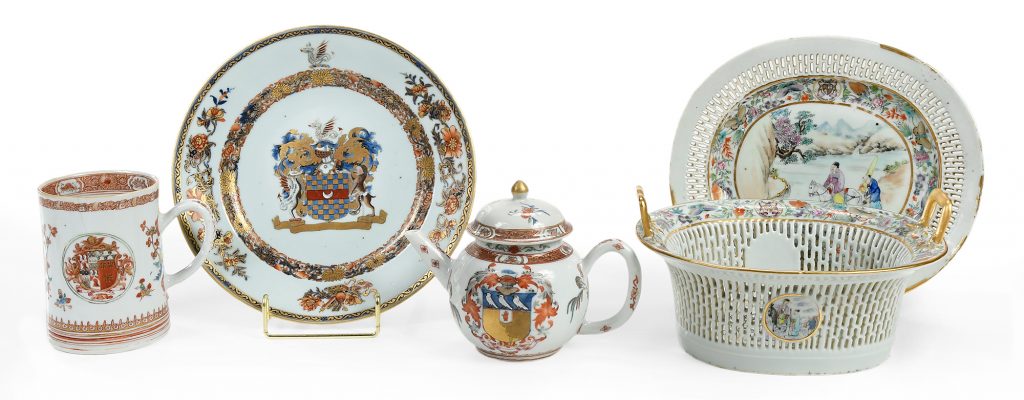Christopher M. Weld: A Collector’s Taste | February 2-4, 2023

Featured in the upcoming Premier Auction, February 4, 2023 at 9 am
Although we first met in the late 1970s in our London gallery of Heirloom & Howard, it was not until the summer of 1991 that Chris and Susie Weld reappeared in our lives. My late husband, David Sanctuary Howard, had long since published his first volume of Chinese Armorial Porcelain and we had just moved from Bath to the chaos of a ramshackle Wiltshire farmhouse. Turning up unannounced, Chris and Susie arrived at the door on our very first morning to find us covered in dust and cobwebs. Our spirits lifted at the sight of them and we abandoned all thought of tasks for the day as we were scooped up for a celebratory lunch instead. After that we became firm friends and the Welds came to stay every time they were in England, often twice a year. Chris became a serious collector and connoisseur of armorial porcelain, later becoming a valued contributor to the Visiting Committee at the Peabody Essex Museum at Salem, MA, near their home.

His taste lay mainly in the earlier services: for bold designs with strong armorials, but above all for their history and associations with so many interesting people of the eighteenth century. He and David would have long discussions, both by phone and letter. Nothing would delight him more than to read a book about one of his “favourite porcelainated families” and to discover a scurrilous titbit about the eccentric owner of a piece in his collection, which would be recounted with glee in one of his witty and frequently irreverent letters. He could always forgive a bit of damage or restoration if the story was good and the piece rare.

The lots that follow display many of these attributes. From the first twenty years of direct trade between Canton and London come two Kangxi pieces in Chinese Imari, in which early palette about thirty British armorial services were made. The service of ca. 1712 made for William Walker, the Judge Advocate, was the first to include tea wares, represented here by the teapot (Lot 751), while a dish of ca. 1718 was made for Sir Gregory Page (Lot 749), a director of the East India Company who died in 1720.
The fashionable tableware decoration of 1720-1730 incorporated iron-red borders, and the services of this decade are all of a high quality of design and made for prominent men: politicians, London merchants, bankers, and East India Company directors. Two plates in the same lot (Lot 744) were made for Anne Boothby and Catherine Talbot, the two daughters of Sir Hugh Clopton of Stratford-upon-Avon, whose ancestor of the same name had owned the house in which Shakespeare lived. Both services have fine baroque armorials and exhibit the craftsmanship of the Chinese painter in accurately interpreting complex European heraldry. Equally fine in both design and execution are two handsome straight-sided tankards of the same period, with the arms of Bromley (Lot 746) and Duncombe (Lot 761). Another rare dish of this period has the arms of Miss King (Lot 741) depicted within a diamond-form known as a ‘lozenge’ indicating the arms of an unmarried lady. Her father, Lord King, was Lord Chancellor, the most senior government post after the prime minister. He ordered several services including this which have the unique distinction of being recorded in the Canton Journals as loaded from the quayside in Canton on the 20th of December 1727. Such personal records are incredibly rare. The diamond-form lozenge, making them provably ordered for women, appears on only about forty services – another in this collection having the arms of Aylmer impaling Hill (Lot 768), this time for a widow.

From a later, neo-classical period a finely painted dish (Lot 766) represents one of the relatively few services for Jewish families, made for Joseph Aguilar of Jamaica and London, and Rebecca, daughter of Aaron Baruh Lousada, while a pierced dish (Lot 755) was ordered for the marriage of James Fector, a banker of Dover, and is known to have been used at a banquet for the Tsar of Russia when he arrived in England on June 6th, 1814; a pair of chestnut baskets of this service are in the Metropolitan Museum.

All of these stories and many more are recounted in the two inscribed volumes of Chinese Armorial Porcelain which together record about four thousand services and are also included in the sale (Lot 778). The second volume was published in 2003 and illustrated several of these pieces from the Weld Collection, as will the unpublished third volume, currently being compiled. Much of the original collection was dispersed to collectors and museums after Chris died in 2017, but many of the pieces that follow were particular favourites that Chris and Susie kept back to enjoy in their retirement apartment until her passing earlier this year.
Angela Howard
West Yatton, December 2022
World-Class Consignments and Exceptional Results